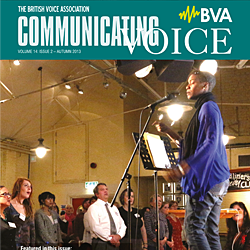About the Association
Archived book reviews
The Language Teacher's Voice
Alan Maley
MacMillan, 2000. ISBN 0333916506
Review by Michael Hendy, Voice Care Network, UK
For Alan Maley, working with teachers' voices is 'a natural extension' of interest in 'what makes learners and teachers tick'. He regards the human voice as the most subtle of all instruments and is amazed at 'our failure' to help teachers to develop and protect their most valuable asset.
This book is published in the Teacher Development Series, which includes Children Learning English and The ELT Manager's Handbook. After work for the British Council on at least three continents and a distinguished period as Director-General of the Bell Educational Trust in Cambridge Alan Maley's time is now divided between universities in Singapore and Bangkok. His experience of teacher training, language learning management and book authorship is second to none in fields relating to the acquisition of English as a foreign or second language (EFL/ESL).
Characteristically he has recognised the need for a book such as this, a gap in the market, if you will. The voice is an asset of even greater importance to the language teacher than to others in the profession. The Language Teacher's Voice is intended for teachers of EFL and ESL, teachers of other foreign/second languages and teachers of first languages, in particular English in the UK. Significantly however, the author adds: "It will also be of interest to teachers of any subject ..." The gap is seen to exist in areas other than those of language teaching.
Expressed aims are to raise awareness of the importance of the voice in professional and personal contexts; to impart practical skills; to provide self-help and class activities; to offer information on use of the voice 'for sustaining physical, psychological and spiritual well-being'. The layout is excellent, so that individual readers can easily find what they may be looking for and the ingredients for class or group activities are clearly displayed. The bibliography is helpfully divided into sections, from books with a voice-training focus to those on therapeutic/spiritual dimensions and those related to ELT pronunciation teaching. A list of useful addresses is headed by those of the BVA and the Voice Care Network.
At 84 pages, this volume clearly covers a lot of ground in a small space. The reader is likely to have come to it with a special need or from a particular direction. A trainee teacher experiencing strain in the classroom may have been guided to it by a tutor. Compilers of training courses might see it as a useful addition to their resources.
Ideas, examples and materials have been assembled for the book from a variety of sources. Each chapter provides a sort of taster for the matter in hand. Exercises in breathing, relaxation, articulation and expressiveness (to name but a few) are not on the whole original.
Although Alan Maley may have adapted them for the context of language teacher training. Indeed full acknowledgement is given throughout to the individual or publication from which a particular idea has come. Also included are significant and encouraging quotations from students who have discovered the potential of their voices in the ways described.
A language teacher wanting to 'do something' about his or her voice will discover useful pointers. Better still, groups of training or practising teachers can sample the activities to find out whether they are appropriate for their own needs. After the 'trailer' provided here, readers and users of the book are guided towards the bibliography for further exploration. However, one's route through the subsequent jungle must be an individual choice, with signposts to all areas from The Actor and the Text (Cicely Berry) to The Tao of Pooh (Benjamin Hoff).
The experienced voice teacher, therapist or trainer will find a good deal of the content to be 'old hat' but that is no bad thing, if the chapeau has so far been unrecognised by certain people. Interest aroused in the importance of maintaining one's instrument in tip-top condition may lead to a wish for professional consultation and help. In The Language Teacher's Voice all 'dimensions' of voice use, from the practical to the spiritual, are presented in a welcoming manner. Whatever one's specialism, there is much to discover and be surprised by. Perhaps the more we are professionally concerned with the mechanics of voice production, the more aware we need to be of teaching and other contexts in which this valuable asset is put to daily use.
More archived content online
Disclaimer
Neither the British Voice Association nor the Editor can be held responsible for errors or any consequences arising from the use of information contained in its newsletters (or extracts from its newsletters published online); the views and opinions expressed do not necessarily reflect those of the British Voice Association (BVA) or the Editor, neither does the publication of advertisements constitute any endorsement by the BVA or Editor of any products or services featured.

 Join us Now!
Join us Now! our newsletter
our newsletter free voice care leaflets & information – download here
free voice care leaflets & information – download here Help our work by donating while you shop
Help our work by donating while you shop